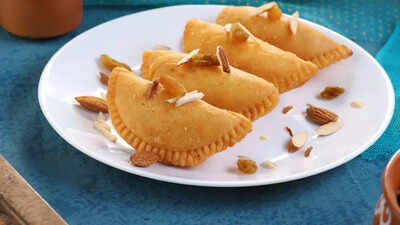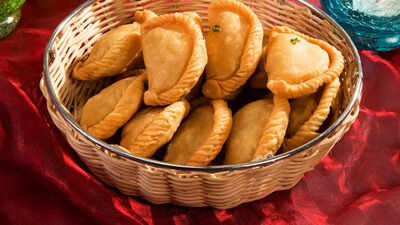Trending
6 ways to make Gujiya more crispy
To achieve crisp and perfect gujiyas for Holi, follow these expert tips. Use cold ghee or oil, add semolina or rice flour, let the dough rest, fry at the right temperature, double fry if needed, and drain excess oil properly. These hacks will ensure your gujiyas turn out delicious and crispy every time.
Holi is around the corner, and in most Indian households preparations are in full swing. Interestingly, Gujiya is that one sweet treat, which is made in most Indian households during this festive season. Well, if too want to make perfect crispy Gujiyas at home, then we have got your back with some simple and amazing hacks to make delicious and crispy Gujiya each time. So, read on and try out these easy hacks.
Use cold ghee or oil
One of the key factors in achieving a crisp gujiya shell is the dough. To make the outer shell extra crispy, use cold ghee or oil when making the dough. Cold fats help create a flakier texture when frying, as they prevent the dough from becoming too soft. The fats form layers within the dough, which puff up and crisp up during frying. If you use warm ghee or oil, it will soften the dough, leading to a chewy and less crispy result.

Adding a small amount of semolina (rava) or rice flour to the dough mixture can help make the gujiya shell extra crispy. These ingredients contribute to the crunchiness, as they absorb less oil while frying and create a crispier texture. Typically, adding one to two tablespoons of semolina or rice flour per cup of all-purpose flour (maida) is enough to achieve the desired result without compromising the taste or texture of the dough.
Let the dough rest
Letting the dough rest for about 20 to 30 minutes before rolling it out is another essential step to make your gujiya crispy. This resting period allows the gluten in the flour to relax, making it easier to roll the dough thin and even. When the dough is rested, it holds its shape better when frying, helping it crisp up faster and evenly. Skipping this step can result in dough that’s too elastic, which may lead to a chewy texture.
Fry at the right temperature
The temperature of the oil plays a crucial role in determining the crispiness of gujiya. If the oil is too hot, the outer shell may burn before the inside cooks properly. If the oil is too cold, the dough will absorb excess oil, resulting in a greasy texture. The ideal frying temperature for gujiya is medium heat. To check if the oil is ready, drop a small piece of dough into the oil. If it rises to the surface slowly and evenly, the oil is at the right temperature.
Double fry
For an extra crispy gujiya, you can try the technique of double frying. First, fry the gujiyas until they are lightly golden and cooked through. Then, remove them from the oil and let them rest for a minute. Heat the oil again to a slightly higher temperature and fry the gujiyas for a second time until they turn a deep golden brown. This double frying process helps in making the outer shell crispier and more evenly golden, giving it a perfect crunch.

Drain excess oil properly
Once the gujiyas are fried, it's essential to drain any excess oil properly. Place the gujiyas on a plate lined with paper towels or a wire rack to allow any residual oil to drip off. This step ensures that the gujiyas remain crisp, rather than becoming soggy from the oil. Avoid covering the gujiyas immediately after frying, as this can cause condensation, which softens the crispy exterior.
End of Article
FOLLOW US ON SOCIAL MEDIA
Visual Stories
Tired of too many ads?











